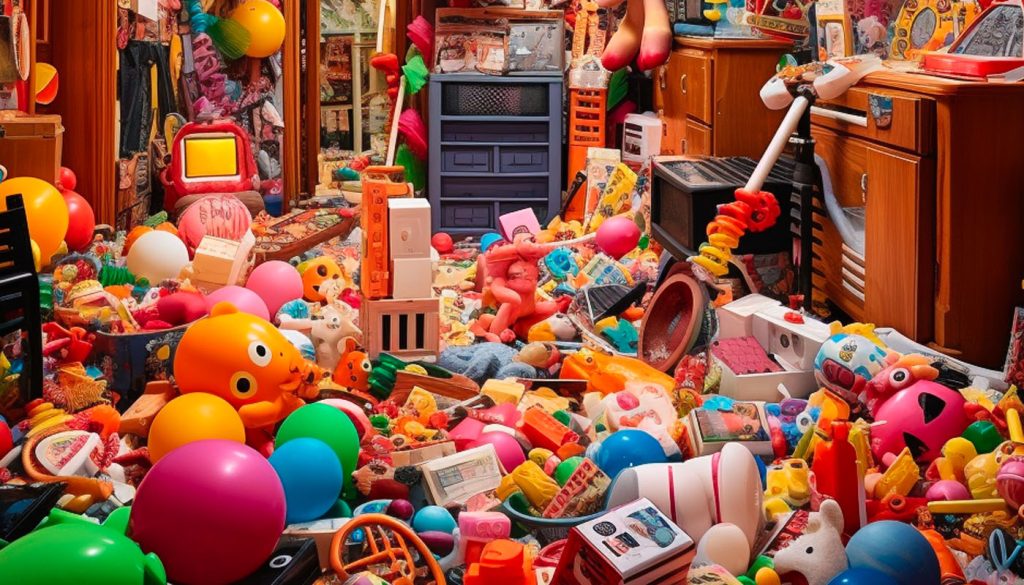When you buy through our links, we may earn a commission. Learn more.
Top Toys of 2010
In 2010, a dynamic blend of high-tech interactive toys and nostalgic classics captured the imaginations of children around the world. This year was marked by the dominance of a certain electronic hamster brand, a surge in technologically advanced playthings, and a strong undercurrent of ageless games that harkened back to simpler times.
Zhu Zhu Pets Phenomenon
Zhu Zhu Pets took the world by storm, becoming the toy of the year and a true childhood obsession. These charming robotic hamsters displayed a unique set of behaviors and could navigate through their own playsets, offering endless fun and making them an instant hit with children.
Revolutionary Tech Toys
The integration of technology into children’s toys took a leap forward with innovative products like Paper Jamz and Loopz. The Paper Jamz Guitar featured a touch-sensitive surface and preloaded tunes which allowed kids to rock out without the need for traditional guitar strings. Loopz combined music, memory, and motion for a gripping game experience that challenged both cognitive and physical skills.
- Tech Toys Table
Toy Name Description Notable Feature Paper Jamz Guitar A paper-thin musical toy Touch-sensitive play Loopz A game of lights and music Tests memory and reflexes Tonka Garage Ricochet RC A remote-control car Double-sided stunts and tricks
Classic Games and Nostalgia
Alongside the wave of cutting-edge toys, favorites like board games and video games saw renewed interest. These toys reminded parents of their own youth, simultaneously offering a shared family experience rooted in nostalgia. Toys like this bridged generational gaps and proved that classic gameplay never goes out of style.
Leading Toy Brands of the Year
In 2010, Hasbro and Mattel were at the forefront of the toy industry, introducing new products that captivated children worldwide. These two toy giants unleashed a variety of toys that not only encouraged imaginative play but also incorporated innovative technologies.
Hasbro’s Innovations
Hasbro, a dominant force in the toy market, made significant strides with their range of products. The Bop-It! series continued to challenge and delight with its fast-paced action and reflex games. G.I. Joe figures embraced the nostalgia of parents while providing children with adventurous and durable toys for action-packed play.
- Star Wars collection was expanded, offering detailed figurines and playsets that coincided with ongoing enthusiasm for the franchise.
- Twister, the classic game that ties players in knots, remained a social and active favorite, proving that not all of Hasbro’s offerings were high-tech.
Mattel’s Creations
Mattel stood out with its diverse collection of toys. The Bratz dolls, known for their stylish outfits and bold personalities, continued to be a hit among those seeking fashion-forward dolls.
- Toy Story Mania rode the wave of the movie’s success, providing tie-in toys that allowed kids to reenact scenes from the beloved Pixar film.
- With a variety of playsets and interactive games, Mattel’s creations catered to different interests, ensuring that they had something for everyone on the toy shelves.
Toy Industry Awards and Recognition
In 2010, certain toys stood out in the industry, garnering significant accolades and proving to be game-changers in terms of innovation and popularity.
Game-Changing Toys
Zhu Zhu Pets were a phenomenon, capturing hearts with their lifelike behavior. They were not just toys; they became a staple of playtime for countless children, simulating the experience of pet ownership without the responsibility. Paper Jamz, with their cutting-edge technology, allowed kids to unleash their inner rock stars, offering an innovative approach to musical play through touch-sensitive paper instruments.
Recognition and Honors
The toy industry’s recognition for these breakthrough products came in various forms. Zhu Zhu Pets received the 2010 “Toy of the Year” award from the Toy Industry Association for their amazing sales and originality. Paper Jamz were finalists in multiple categories, highlighting their unique contribution to interactive play and technology integration in toys.
Here are the key awards where these toys left their mark:
- Zhu Zhu Pets
- Toy Industry Association Awards:
- Toy of the Year
- Innovative Toy of the Year (Finalist)
- TIME Magazine
- Top 100 Toys of All Time (Included)
- Toy Industry Association Awards:
- Paper Jamz
- Toy Industry Association Awards: (Finalist in various categories)
- Most Innovative Toy
- Best Boy Toy of the Year (Finalist)
- Toy Industry Association Awards: (Finalist in various categories)
These recognitions underscore the impact that these inventive products had on the toy market and how they set trends for years to come.
Play and Development
Toys in 2010 capitalized on the excitement of interactive play and skill enhancement, offering children new avenues for both creative expression and cognitive development.
Interactive Gameplay
In 2010, Nintendo Wii set the standard for interactive gameplay with its innovative motion-sensing technology. Children and families were enthralled by the ability to participate in virtual sports and adventure games, directly influencing the game and terrain by their physical actions. Tactile and engaging, the Wii encouraged active play in a digital format, proving video games could be both fun and physically stimulating.
Star Wars toys introduced novel ways to engage with the beloved franchise. The iconic Star Wars legacies were carried on through toys that allowed fans to recreate battles and stories, with droid and mech models taking a central place in the hearts of young Jedis. These toys not only represented characters from the movies but also encouraged children to role-play and interact with each other in elaborate scenarios.
Educational and Skill Development
2010 also saw a rise in toys that fostered educational growth and skill development. The Harumika fashion design line, for instance, let children explore the world of fashion without the need for needles or thread. They could combine different fabrics and accessories on a mannequin to create unique designs, enhancing their sense of style and creative thinking skills.
For those inclined towards engineering and construction, the TRIO building set became a staple. Kids could snap together pieces to construct buildings, vehicles, and much more. It helped children understand properties of geometric shapes, basic engineering concepts, and the joy of creating something from scratch, thereby ticking boxes for both fun and learning.
With a focus on growth and happiness, the most popular toys of 2010 played a critical role in children’s developmental stages by combining enjoyment with educational value.
Evolution of Toy Properties
The transition from traditional playthings to digital entertainment marked a significant shift in toy properties in 2010. Franchises expanded across multiple platforms, satisfying the diverse preferences of children worldwide.
From Playsets to Video Games
Throughout the past decade, video games became a dominant force in the toy industry. The Nintendo Wii, released in the late 2000s, continued its popularity into 2010. Its motion-sensing capabilities bridged the gap between physical and digital play, bringing an innovative twist to the concept of toys. Traditional toy lines, like Star Wars and Toy Story, leveraged their popularity by branching into the video game market, with titles such as Toy Story Mania! providing an interactive experience that was once solely available in physical playsets.
Expanding the Toy Universe
Bratz dolls exemplified the evolution of the toy universe by expanding their property through a variety of media, including movies, TV series, and video games, which complemented their physical dolls. Slime, while simple in concept, soared in popularity due to its satisfying sensory experience and endless customization possibilities. Both Bratz and slime, though different in nature, illustrate how toys evolved beyond their initial form to create immersive worlds and experiences that captivated children’s imaginations.
I’m Cartez Augustus, a content creator based in Houston, Texas. I’ve been exploring a variety of niches in content marketing in order to increase website traffic. I enjoy experimenting with artificial intelligence, search engine optimization, and paid search. The process of creating nerd-related content has been extremely rewarding since it has enabled me to network with people who are knowledgeable about these subjects.







